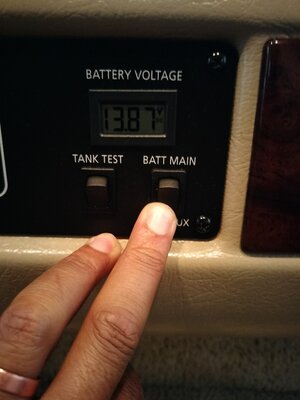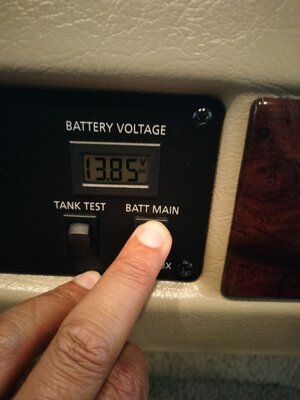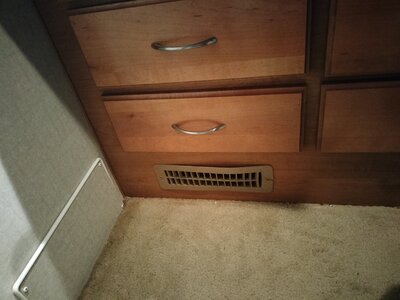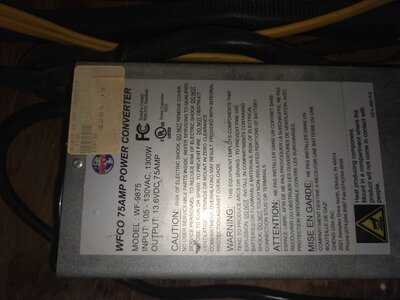I'll give it a shot. Sorry if this I sound dumb but which one is the inverter?Check to see what the voltage is going into and coming out of the inverter. Check the same in and out of the transfer switch. If the voltage is low or no-existent at any of these points, it will help to narrow down the source of the problem.
Also, did you check the voltage at the pole?
This may be good to have, if you are not using an EMS, like, Progressive industries, of Hughes watchdog.
Journeyman-Pro 30/50 Amp RV - Portable Circuit Tester Analyzer Adapter, Male Plug w/LED Test Indicator TT-30 NEMA 14-50 (TT-30 (30 AMP), Circuit Tester (Male Only))
Start at the pole and work your way in.
Navigation
Install the app
How to install the app on iOS
Follow along with the video below to see how to install our site as a web app on your home screen.
Note: This feature may not be available in some browsers.
More options
Style variation
Welcome to RVForums.com
- Register now and join the discussion
- Friendliest RV Community on the web
- Modern site for PC's, Phones, Tablets - no 3rd party apps required
- Ask questions, help others, review campgrounds
- Get the most out of the RV Lifestyle
- Invite everyone to RVForums.com and let's have fun
- Commercial/Vendors welcome
You are using an out of date browser. It may not display this or other websites correctly.
You should upgrade or use an alternative browser.
You should upgrade or use an alternative browser.
Help, house batteries not charging.
- Thread starter Ellano
- Start date
RKins
RVF Expert
- Joined
- Nov 15, 2019
- Messages
- 937
- Location
- Sarasota, FL
- RV Year
- 1997
- RV Make
- Newmar
- RV Model
- London Aire
- RV Length
- 40'
- Chassis
- Spartan
- Engine
- 6CTA 8.3L Cummins.
- TOW/TOAD
- 2008 Jeep GC Overland
- Fulltimer
- No
That sounds normal. Do you have only one aux batt? If you have room, you could hook another battery in parallel to get more current available for boondocking, which will give you more time before the battery level is unusable. Do you have a manual for the Intellitec EMS?Ok, yes. When it's just batteries , all low voltage items work but drain the battery quickly. Like if I have 2 lamps on and battery voltage is at 12.5 v, after 30 minutes the aux batt voltage is down to 11 and steadily dropping.
B52Bombardier1
RVF VIP
- Joined
- Nov 28, 2021
- Messages
- 249
- Location
- Louisiana
- RV Year
- 2007
- RV Make
- Explorer
- RV Model
- Scout
- RV Length
- 18 feet
- TOW/TOAD
- 2017 Chevy Silverado 4x4
- Fulltimer
- No
I think you are going to need an electronic "multimeter" soon to analyze your situation. This device will tell you if your system is providing recharge current to your batteries under all conditions and if perhaps the recharger is letting too much alternating current through its diodes.
There are plenty of You Tube videos on how to operate a multimeter. Harbor Freight, Lowes and Home Depot all should have them in stock.
Are you still running incandescent lamps or have they been converted to LED lamps? The LED style consumes MUCH LESS current for the same amount of light.
And how big are these "exhaust fans" that you mentioned?
Rick
There are plenty of You Tube videos on how to operate a multimeter. Harbor Freight, Lowes and Home Depot all should have them in stock.
Are you still running incandescent lamps or have they been converted to LED lamps? The LED style consumes MUCH LESS current for the same amount of light.
And how big are these "exhaust fans" that you mentioned?
Rick
AbdRahim
RVF Supporter
- Joined
- Dec 25, 2019
- Messages
- 3,938
- RV Year
- 2020
- RV Make
- Newmar
- RV Model
- BayStar 3626
- RV Length
- 37’
- Chassis
- Ford
- Engine
- V10
- TOW/TOAD
- None
Should have asked how many batteries you have. On my previous class C, if I ran a fan and a light or for, only for 3 hours or so, my batteries would not last overnight, That is they would be down to 50% or less ( 2 100AH batteries. My current class A has six 6v house batteries (200+ AH each). Of course it has a residential fridge, but batteries are often down 50% (12.1v or so) running only the refrigerator, and phone charger, night light, overnight. Unless you have a large battery bank or lithium batteries, they won't go very far before needing charging.
Inverter will have heavy battery cables going to it.
Inverter will have heavy battery cables going to it.
Final update. After some back and forth with the dealer, they sent out a tech at no cost and the guy took 2 mins to figure it out. Said one of the capacitors on the converter went kaput so it was receiving shore power but dishing out little to none. Dealer purchased me a new converter and I installed it myself. Now I'm reading 13.8 and 13.6 across house and chasis batteries. Hopefully all this voltage dropping didn't kill the batteries and they can hold a charge. Thanks for all the help. I'll attach some pics of the converter. It was hiding under a drawer.
Attachments
DennisT
RVF Supporter
- Joined
- Dec 1, 2022
- Messages
- 1,284
- RV Year
- 2022
- RV Make
- Newmar
- RV Model
- Superstar 4061
- RV Length
- 41
- Chassis
- FCCC
- Engine
- Cummins 360
- TOW/TOAD
- 2022 Jeep Cherokee TrailHawk
- Fulltimer
- Yes
Similar threads
- Replies
- 4
- Views
- 1K
Latest resources
-
-
Trueline Leveling System (Valid Air)Operation & Service Manuals for the Valid Air leveling system
- Jim
- Updated:
-
-
Notes on the Electrical Systems of the Roadtrek Zion Family of RVsNotes on the Electrical Systems of the Roadtrek Zion Family of RVs
- dilbertjth
- Updated:
-















